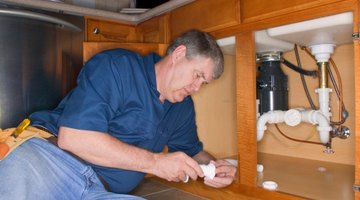Troubleshooting a GE Water Softener GXSF39E
If you live in an area with hard water, you might be using a GE GXSF39E water softener. This softener features a recharge countdown, six-hour memory (in case of a power outage) and an electronic diagnosis system.

If your GE water softener is not working effectively, try troubleshooting it before calling an expensive repair person or replacing the system.
Things You Will Need
- Water softener salt
- Fuse, if necessary
- 1 1/2 tablespoons household bleach
Lack of Soft Water
-
Check the water softener’s power supply. Make sure it is plugged into a working outlet. Look at the circuit-breaker or fuse box. Reset tripped breakers and/or replace blown fuses.
-
Check the water softener system's salt level. If it is not at least 1/3 full, add water softener salt to the system.
-
Open the cover. Make sure there are at least 3 gallons of water in the tank. Pour salt into the tank until it is full. The unit can hold about 200 pounds of salt.
-
Inspect the bypass valve stem to be sure its knob is correctly positioned. It should be in the “Out” position.
-
Look at the drain hose to be sure it is not kinked or clogged. Kinks and clogs make the hose nozzle operate improperly and restrict the system from recharging and softening water effectively.
Occasional Hard Water
-
Contact a laboratory to have your water tested by a professional laboratory if you notice an increase in hardness grains in your water supply, especially if you have well water. Reposition the “Hardness” control as determined by the laboratory results.
-
Push “Mode” until “Hardness” is displayed. Check the hardness number to be sure it matches the number of grains of hardness in each gallon of your water supply. If the hardness number does not match the desired number, reprogram the system according to the manufacturer’s instructions.
-
Refrain from using hot water while the system recharges, because this will make the system fill with hard water.
Salty or Brown Water
-
Sanitize the water softener. Place 1 1/2 tablespoons of household bleach in the softener’s brinewell, which is the tube down inside the softener unit. Push the “Recharge” button on the top of the softener. Hold it for 3 seconds. Once the display begins to flash “Recharge,” wait about 2 hours for the unit to finish the sanitization process.
-
Check your home’s water pressure. If the height of the water softener drain is more than 8 feet, the pressure should be at least 50 pounds per square inch (psi). If it is 8 feet or under, the minimum is 20 psi. Contact a licensed plumber for assistance in determining water pressure to your home.
-
Inspect the drain hose for sharp bends or clogs. Reposition or unclog the line, if necessary.
Miscellaneous Problems
-
Call a service technician if resin beads appear in the water. This indicates that the water softener system has a cracked distributor.
-
Allow the system to run awhile if the water produced is cloudy or bubbly. This is normal after installation.
-
Contact a testing laboratory immediately if the water appears blue after you install the system. This means there is acidic water flowing through copper water lines, causing copper to leach into the water.
-
Avoid drinking the water until the problem is fixed, because it could cause nausea and vomiting. Long-term copper exposure may result in kidney or liver problems, according to Javed Iqbal, lab manager at the W.A. Callegari Environmental Center at Louisiana State University's AgCenter.
-
If your dishes begin to look milky or cloudy, reduce the amount of dishwasher detergent you use.
The Drip Cap
- If you live in an area with hard water, you might be using a GE GXSF39E water softener.
- Check the water softener system's salt level.
- Contact a laboratory to have your water tested by a professional laboratory if you notice an increase in hardness grains in your water supply, especially if you have well water.
- Reposition the “Hardness” control as determined by the laboratory results.
- Push the “Recharge” button on the top of the softener.
- If the height of the water softener drain is more than 8 feet, the pressure should be at least 50 pounds per square inch (psi).
- Inspect the drain hose for sharp bends or clogs.
- Call a service technician if resin beads appear in the water.
- Avoid drinking the water until the problem is fixed, because it could cause nausea and vomiting.
References
Writer Bio
Michelle Skidgel has worked as a writer and editor since 2001. She earned her Bachelor of Arts degree in English at Oklahoma State University and is currently raising and homeschooling five children with her husband. Her articles for various websites specialize in parenting, green living, gardening, cooking and frugal living.
Photo Credits
- Jupiterimages/liquidlibrary/Getty Images
- Jupiterimages/liquidlibrary/Getty Images
More Articles



